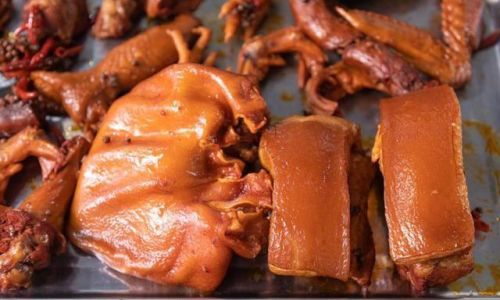Introduction

The culinary world is a vast and ever-evolving landscape, where traditional dishes meet modern twists, and familiar flavors find new expressions. Among the myriad of delicacies that dot this landscape,卤味 (marinated and spiced meats), a staple in many Asian cuisines, stands out for its rich, complex taste and versatility. Whether it’s a spicy chicken wing, a tender pork belly, or a savory tofu skin,卤味 offers a delightful blend of spices and marinades that tantalize the taste buds. But how does one achieve that perfect balance of flavors, ensuring that every bite is a burst of umami and delight? This article delves into the intricacies of making卤味 more flavorful, exploring techniques, ingredients, and tips that will elevate your卤味-making skills to new heights.
Understanding the Basics of卤味
Before diving into the specifics of enhancing flavor, it’s crucial to understand the fundamentals of卤味.卤味, broadly translated as “marinated and spiced meats,” encompasses a wide range of cooked meats and tofu products that have been soaked in a fragrant, spicy broth. This broth, typically made from a combination of soy sauce, spices, herbs, and sugar, is the cornerstone of卤味的 flavor profile. The meats are then simmered slowly, allowing the flavors to penetrate deeply into the flesh, resulting in a dish that is both tender and bursting with flavor.
Key Ingredients for a Flavorful卤味
-
Soy Sauce: The backbone of卤味 broth, soy sauce provides the essential umami that defines the dish. Dark soy sauce adds color and a deeper, richer flavor, while light soy sauce offers a brighter, more balanced taste.
-
Spices and Herbs: A blend of spices such as star anise, Sichuan peppercorns, cinnamon, and cloves creates a complex, aromatic profile. Herbs like garlic, ginger, and scallions add freshness and depth.
-
Sugar: A touch of sugar balances the savory and spicy elements, rounding out the flavors and creating a harmonious taste.
-
Rice Wine or Shaoxing Wine: These alcoholic beverages add a layer of sweetness and complexity, enhancing the overall flavor profile.
-
Chili Peppers and Chili Oil: For those who prefer a spicy kick, chili peppers and chili oil are essential. They add heat and vibrancy, elevating the dish to new levels of excitement.
-
Meats and Tofu: The choice of protein is crucial. Chicken, pork, beef, and tofu all absorb flavors differently, so experimenting with various types can yield surprising results.
Techniques for Enhancing Flavor
-
Marinating: Before simmering, marinating the meats in a mixture of soy sauce, rice wine, spices, and herbs can significantly boost flavor. This step allows the ingredients to penetrate the meat, ensuring deeper, more pronounced flavors.
-
Simmering: The art of simmering lies in patience and temperature control. A gentle simmer allows the flavors to meld together slowly, creating a rich, flavorful broth. Overcooking can lead to dry, tasteless meat, so keeping a close eye on the cooking process is vital.
-
Skimming the Fat: Regularly skimming the fat from the surface of the broth ensures a cleaner, clearer flavor. Fat can overpower the delicate spices and herbs, so maintaining a broth that is clear and uncluttered is key.

-
Adjusting Seasoning: Taste the broth periodically during simmering and adjust the seasoning as needed. This ensures that the final dish is perfectly balanced, with no single flavor overpowering the others.
-
Finishing Touches: Once the卤味 is cooked, adding a drizzle of chili oil, sesame seeds, or chopped scallions can provide a fresh, vibrant finish. These toppings not only enhance the visual appeal but also add an extra layer of flavor.
Advanced Techniques for a Gourmet卤味 Experience
-
Using Aromatics: Incorporating aromatic vegetables like carrots, onions, and celery can add subtle sweetness and depth to the broth. These vegetables should be sautéed before adding to the broth, to release their natural sugars and flavors.
-
Smoking: Smoking the卤味 can add a smoky, earthy flavor that complements the spices and herbs. This can be done using a smoker box or by wrapping the卤味 in foil with a handful of wood chips.
-
Infusing with Extracts: Extracts like vanilla, rosewater, or even orange peel can add unexpected notes of sweetness and complexity. Use them sparingly, as their flavors can be quite intense.
-
Glazing: For a glossy, caramelized finish, brush the卤味 with a mixture of honey, soy sauce, and a touch of cornstarch before broiling. This not only adds a beautiful shine but also creates a sweet, sticky crust that contrasts beautifully with the savory meat.
-
Experimenting with Different Spices: While traditional卤味 spices are a must, don’t be afraid to experiment with less common spices like cardamom, coriander seeds, or even a hint of nutmeg. These can add unique, intriguing flavors that set your卤味 apart.
Serving and Enjoying卤味
Serving卤味 is as much an art as making it. Presentation is key, so arrange the pieces attractively on a platter, garnishing with fresh herbs, chili flakes, or even a drizzle of lime juice for a zesty kick.卤味 is best enjoyed at room temperature or slightly chilled, as this allows the flavors to develop and meld together even more. Pair it with a cold beer, a refreshing soda, or a cup of fragrant jasmine tea for a complete dining experience.
Conclusion
Making卤味 more flavorful is a journey that requires patience, experimentation, and a deep understanding of the ingredients and techniques involved. By mastering the basics and embracing advanced techniques, you can create卤味 that is not only delicious but also unique, reflecting your personal culinary style. Remember, the key to a successful卤味 lies in balance – a harmonious blend of spices, herbs, and meats that dance together on the palate, leaving a lasting impression. So, roll up your sleeves, fire up the stove, and embark on a culinary adventure that will delight your taste buds and impress your guests. Happy卤味-making!





0 comments